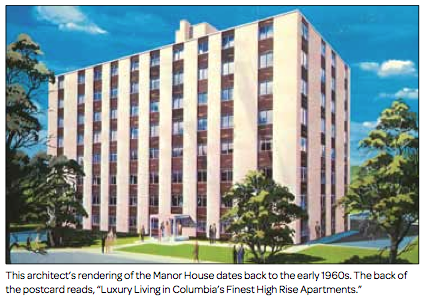Building Up? Or Holding Back?
 Now just another university dorm, 50 years ago the eight-story Manor House apartment building at 306 Hitt St. was strictly off limits for most students. This was the first significant addition to the city’s profile since the Walnut Street water tower was built in 1945. A project of St. Louis developer R.T. Crow, who also built White Gate Village, only a few multistory structures have gone up since then. That is, until now.
Now just another university dorm, 50 years ago the eight-story Manor House apartment building at 306 Hitt St. was strictly off limits for most students. This was the first significant addition to the city’s profile since the Walnut Street water tower was built in 1945. A project of St. Louis developer R.T. Crow, who also built White Gate Village, only a few multistory structures have gone up since then. That is, until now.
With thousands of student-themed “beds” already on line and a more luxurious, somewhat sturdier six-story building at 306 S. Ninth St. towering over them, a half dozen or so proposals are lined up at the gate waiting for the city to allow construction to begin. Or will it? Until the city upgrades infrastructure, notable water, power and sewer systems, the only noise you may hear are sighs of frustration as prospective developers ride out of town in quest of sunnier prospects elsewhere.
Cost of infill development
City officials are embarrassed they didn’t respond more quickly to these infrastructure shortcomings, somewhat ironic given strident advocacy by some solons pressing for “infill” development downtown. Most urgent is the need for larger sanitary sewer lines, and that means tearing up streets and other rights-of-way. Not that there’s a cornucopia of cash lying around; the money needed for these projects comes in seven-figure chunks leaving the city in a pickle about raising the necessary funds.
Now the city seems almost in a panic about how to quickly raise the money. Seeking resident approval to issue tax-exempt municipal bonds to fund these upgrades has been sidelined for now, supplanted by efforts to create an ambitious municipal tax increment financing (TIF) district. Then, at least one City Council member who opposes the TIF concept keeps dredging up the idea of charging “impact” fees that, if enacted, would probably send prospective developers scurrying elsewhere.
Now Boone County, which collects and disburses property taxes, has thundered on to the scene with a lawsuit vowing to oppose the city’s TIF proposal. Ah, such cooperative neighborliness; it’s the makings of an old-fashioned gunfight in the East Walnut Street corral, energized by what some perceive to be the city’s arrogance charging ahead with a somewhat unique municipally sponsored TIF district. Revolvers drawn, county officials should cool their heels because this calls for mediation and compromise, not intolerance and bombast.
For the good of the county
We have long marveled at the contrast between the city’s charter-based council-manager home-rule system of governance and the antiquated single-party political “machine” that rules Boone County. The county and its residents have consistently failed to enact a home-rule charter out of fear it would dismantle the longstanding arrangement of, in this case, rarely challenged Democrats who control all the offices and mechanics of governance. Perhaps with a home-rule charter and a more rational, politically neutral county executive, the county wouldn’t have barged ahead with this impish foolishness.
These are good people. We admire them for their competence and devotion free of any notion of impropriety since the mid 1970s. Now they are acting like spoiled brats in a sandbox. County officials should be reprimanded for failing to grasp the bigger picture and husband the economic well-being of the county they preside over. They need a tutorial about the economic significance of the University of Missouri.
Most of the proposals awaiting the go-ahead are for buildings filled with beds to satisfy the thirst for housing at MU as the university, Boone County’s largest employer, presses toward an enrollment of 40,000 students. Over the longer term, the increased value of each property as a “ratable”—that is, the leap in assessed valuation upon completion—will yield more taxes for the county to disburse among various entities including the public schools. Show us the numbers. If Columbia’s TIF proposal is so ruinous to the financial well-being of our public schools and other property tax-supported entities, we need some proof of this. The city could simultaneously reduce the TIF district boundaries and pare the list of projects it proposes to fund. Boone County should suffuse itself with the spirit of compromise and negotiate with the city to make this a win-win for everyone.
Remember, our negligence to embrace those who wish to invest here would be to spurn economic opportunities any other community would champ at the bit to welcome.








